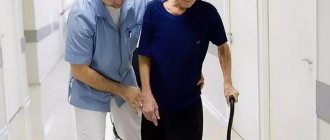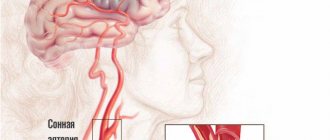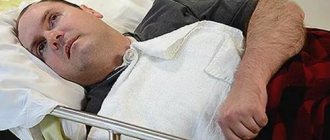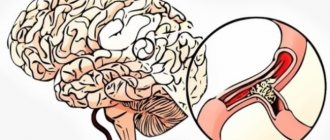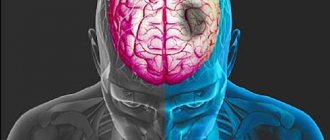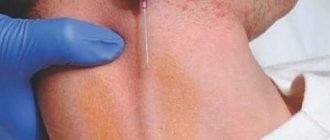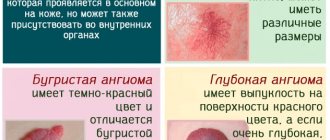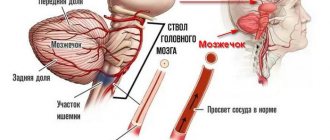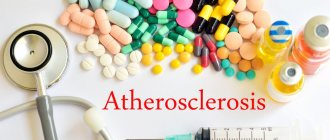Description of the disease
An ischemic stroke occurs due to obstructions in the vessels that supply blood to the brain. Such obstacles can be fatty deposits and blood clots. The disease is based on 3 pathologies associated with circulatory disorders - ischemia, stroke, and heart attack.
Reference: ischemia is the insufficiency of blood supply to an area of tissue or organ, and stroke is the death of brain tissue due to impaired blood flow due to ischemia or rupture of blood vessels.
What causes a cerebral stroke?
There is no single cause of stroke, so it is worth mentioning the combination of risk factors that cause it. One of the main factors is heredity . When a patient has “weak” vessels (genetically determined weakness of connective tissues is noticed), the person may form an aneurysm, which, having acquired a certain size, can “burst” and a hemorrhagic stroke occurs. Or a person is prone to the accumulation of cholesterol, then atherosclerotic plaques form in the vessels, narrowing the lumens and predisposing to the appearance of a blood clot. The causes of stroke, such as smoking, hypertension, arrhythmia, excess weight and diabetes, also affect. Therefore, no one can be immune from stroke.
Spinal stroke
A spinal stroke is a rare but dangerous pathology in which there is a disruption of the blood supply to the spinal cord.
When compared with cerebral stroke, spinal stroke is less likely to cause death, but often causes severe disability . According to the frequency of detection among other diseases, spinal stroke is diagnosed in 1% of cases.
The development of pathology begins with pain in the lumbar region, lameness, and problems with urination. Then the limbs become numb and their sensitivity is lost.
Types by TOAST
Currently, the generally accepted classification of pathogenetic subtypes of ischemic stroke is the TOAST classification.
There are five types of ischemic stroke: due to atherosclerosis of large arteries (atherothromboembolic), cardioembolic, due to occlusion of a small vessel (lacunar), stroke of another established etiology, and stroke of unknown etiology.
- Atherothrombotic attack. It is provoked by atherosclerosis of a medium or large artery.
- Lacunar. Occurs against the background of hypertension, diabetes, affecting small arteries.
- Cardioembolic. It becomes a consequence of blockage of the middle cerebral artery (MCA) by an embolus.
- Ischemic stroke , developing as a result of rare causes - increased blood clotting, hematological diseases, dissection of the arterial wall, etc.;
- Of unknown origin. Pathology occurs for unknown reasons.
Bibliography
- Boyko A.N., Kabanov A.A., Eskina T.A. et al. The effectiveness of Phezam in patients with chronic forms of cerebrovascular accident. Journal of Neurology. and a psychiatrist. 2005: 9:11; 36-41.
- Gekht A.B., Bogolepova A.N., Sorokina I.B. Depression after stroke: experience with cipramil. Journal of Neurology and Psychiatry. Korsakov. 2002; 5: 36-39.
- Martynov M.Yu. Ischemic stroke in patients with dyscirculatory encephalopathy. Auto. diss. Doctor of Medical Sciences. M., 1995.
- Ushakova S.E., Kontsevaya A.V., Knyazhevskaya O.V. et al. Effect of therapeutic education of patients with arterial hypertension on adherence to treatment. Cardiovascular Therapy and Prevention 2005: 1; 45-51.
- Shalnova S.A., Deev A.D., Vikhireva O.V. and others. Prevalence of arterial hypertension in Russia: awareness, treatment, control. Disease Prevention and Health Promotion 2001; 2:3-7.
- Skvortsova V.I. Cerebrolysin in the treatment of acute ischemic stroke. IY International Symposium “Cerebrolysin: pharmacological effects and place in clinical practice.” Moscow, 2002. pp. 28-35.
Periods
A stroke, as impaired blood circulation in an area of the brain, is distinguished by the timing of its onset.
In total, doctors distinguish 5 stages of stroke:
- the most acute period – the first 72 hours;
- acute period – up to 28 days;
- early recovery period – up to 6 months;
- late recovery period – up to 2 years;
- residual effects – after 2 years.
In most cases, ischemic strokes occur suddenly and develop rapidly, causing the death of brain tissue in a period from a couple of minutes to a couple of hours.
What it is?
Ischemic stroke is a condition in which the functions of the brain are disrupted.
In one specific area of the brain, blood circulation is disrupted, and its tissues simply die. Doctors call this critical condition a cerebral infarction.
ICD 10 code
In the global scientific community, there is an international basic classifier of diseases, the so-called ICD 10. According to its classification, stroke is assigned code 160-169 with the label “Cerebrovascular diseases” .
Also, ICD-10, when formulating a diagnosis, calls ischemic stroke a pathology leading to severe disorders in the body.
Medical history in neurology
Doctors see the cause of ischemic stroke in the fact that there is a sharp narrowing of the arteries that supply oxygen to the human brain. As a result, brain cells stop receiving enough oxygen and begin to atrophy. Ischemia and necrosis of brain tissue occurs.
Naturally, a person’s well-being suddenly deteriorates sharply, and his salvation depends on the speed of medical care provided to him.
Differences from transient attack
A stroke-like condition is transient ischemic attack. Here, too, vasoconstriction and brain hypoxia occur. But unlike ischemic stroke, this is only a temporary condition and does not cause brain necrosis.
A transient ischemic attack can last from ten minutes to a day, then brain functions are completely restored. Doctors call this condition a harbinger of ischemic stroke and strongly recommend that patients who have had at least one such attack receive timely treatment.
Our specialists have prepared materials for you about the differences between an ischemic and hemorrhagic attack, as well as about the characteristics of an ischemic stroke on the right and left side of the brain.
Classification by affected area
The classification of cerebral infarction also takes into account the location of the lesion. Taking into account localization, the following strokes are distinguished.
Right-handed
The consequences affect the motor functions of the left side of the body, with a poor prognosis for recovery (sometimes up to paralysis). Psycho-emotional indicators remain almost normal;
Left-handed
Speech and the psycho-emotional sphere suffer, but motor functions can be fully restored . After such a defeat, the patient can only use simple phrases and individual words; he cannot form or perceive complex ones.
Cerebellar
The result is impaired coordination of movements, nausea to vomiting, and dizziness. After 24 hours, the cerebellum presses on the brain stem, the person’s facial muscles become numb, coma often begins, and death often occurs;
Extensive
It is detected against the background of the cessation of blood supply to a large area of \u200b\u200bbrain tissue. Swelling appears, then paralysis with a poor prognosis for recovery.
Important: despite the fact that stroke occurs more often in older people, there is a risk of the condition occurring at any age.
Therefore, prevention and a healthy lifestyle come to the fore.
Minor ischemic stroke
A minor stroke, or microstroke, is characterized by the disappearance of pathological symptoms (paresis, speech and vision impairment) within 3 weeks.
After this period, the person can return to their normal lifestyle.
The causes of the condition are the same as with a regular stroke - atherosclerosis plaques, blood clots in blood vessels, hemorrhages . It is important not to ignore a small stroke, as it signals problems with the blood vessels of the brain. If you do not take action, you can expect a real stroke in the future with the consequences described above.
You can differentiate a micro-stroke from a hypertensive crisis by numbness of the limb, a feeling of pins and needles, and blurred speech . Such symptoms will not be detected during a hypertensive crisis. If the symptoms described above disappear within 21 days, we can confidently say that the person has suffered a minor ischemic stroke.
In children
An acute disruption of the blood supply to the brain in a child leads to a stroke. Precursors and symptoms of pathology in children differ from similar signs in adults. A problem can be suspected by squint, rapid eye movements, instability of body temperature, convulsions, tremors of the limbs, hypo- or hypertonicity of muscles.
A sharp decrease in blood pressure, hearing problems, nausea to vomiting, painful headaches, dizziness - all this may indicate a stroke in a child. In infants, it is more difficult to identify the pathology, but there are several signs - the baby often cries, changing his voice, or tenses his facial muscles, in addition, he reacts sharply to light and sound.
Ischemic stroke with hemorrhagic impregnation
The hemorrhagic form is considered the most severe type of stroke, with a mortality rate of up to 90%.
The condition begins against the background of a hypertensive crisis, stress, and excessive physical exertion. If ischemic stroke is more often detected in old age, then hemorrhagic stroke is detected in young and mature people, more often in males.
Great psycho-emotional stress causes apoplexy even in 18-year-old people.
A stroke with hemorrhagic impregnation is otherwise called diapedetic hemorrhage. In this condition, fluid effusion from damaged vessels into the surrounding space is observed.
The fluid accumulates and permeates the brain tissue, resulting in reactions that provoke brain swelling and compression of the nervous structures to a critical state.
Main risk groups
Every year, about 400,000 cases of stroke are registered in the country, of which 35% result in the death of the patient. The risk of hemorrhage increases significantly if a person leads an unhealthy lifestyle. People over 55 are also more susceptible to the impact.
However, in recent years, more and more young people (15-45 years old) have begun to experience stroke. Cases of ischemic stroke in patients aged 5-14 years increased by 31%, in patients aged 15-34 years - by 30%, and in patients aged 35-47 years - by 37%.
The following factors can lead to the development of a stroke:
- bad habits (excessive smoking, drinking alcohol, drugs);
- poor diet, which increases cholesterol levels;
- presence of cardiovascular diseases;
- lack of normal physical activity, constant stress.
Clinic
The symptoms of an ischemic stroke usually manifest themselves abruptly, literally in a matter of seconds or minutes. Rarely, signs appear gradually over a couple of hours or days. The clinical picture depends on the location of the brain damage.
This may be blindness in one eye, weakness or paralysis of a limb, inability to understand the speech of others, or inability to speak.
There may also be double vision, body weakness, disorientation in space along with dizziness.
Important! If the symptoms listed above occur, you should immediately call an ambulance - the sooner help is provided, the more favorable the prognosis.
Symptoms of a cerebral stroke
Symptoms that indicate a brain stroke may appear suddenly. Starting from the first minutes, coordination of movement is disrupted, sensitivity in the limbs and face disappears, and the gait changes.
The main symptom is the sudden and rapid onset of neurological disorders.
- Weakness. Sudden weakness or numbness of half the face and limbs.
- Speech problems. Sudden inability to communicate or recognize speech.
- Vision problems – partial or complete loss of vision or double vision.
- Headache.
- Poor balance and inability to walk without assistance.
Diagnostics
Diagnostic measures aimed at making a diagnosis are reduced to the following examinations:
- taking an anamnesis, physical and neurological examination, identifying concomitant diseases that can provoke ischemic stroke;
- laboratory tests (coagulogram, blood biochemistry, lipid analysis);
- ECG;
- blood pressure measurement;
- CT or MRI of the brain to identify the location of the lesion, size, period of formation.
Diagnostics is aimed at determining the affected area, differentiating it from epilepsy, tumor, hemorrhage and other diseases with a similar clinical picture.
Rehabilitation after stroke
In rehabilitation after stroke, the Yusupov Hospital uses an integrated approach to ensure the best recovery for patients. Physiotherapists, speech therapists, massage therapists, exercise therapy instructors, and occupational therapists work with the patient. Physiotherapy and exercise therapy can help restore motor functions. The massage therapist eliminates muscle spasms and normalizes their tone. The speech therapist's task is to restore speech and swallowing. An ergotherapist helps to adapt to new living conditions and teaches everyday skills.
The human brain has a unique property - neuroplasticity - the ability to regenerate. New connections between neurons are formed in the brain, due to which lost functions are restored. Neuroplasticity can be stimulated, which is what happens during the rehabilitation process. Regular exercises, which are selected individually depending on what function is to be restored, must be performed constantly, every day until the desired effect is obtained. Regularity is a key factor in achieving your goal; without it, it is impossible to achieve any results.
During the rehabilitation process, various elements of breathing exercises and intellectual exercises are used. All this helps the brain work better and better. Also in rehabilitation, various simulators can be used to help learn how to walk again or perform any action (for example, alternately bending and straightening fingers), provoking its implementation.
An important part of rehabilitation is moral and psychological support. The development of post-stroke depression significantly worsens the patient's condition. This condition can be caused by social isolation, lack of desired results in treatment, and certain medications.
Treatment
Therapy is aimed at maintaining the basic functions of the body (breathing, heart and blood vessels).
If cardiac ischemia is detected, antianginal drugs are prescribed, as well as drugs to improve the pumping function of the heart, antioxidants, glycosides, etc.
Procedures are performed to prevent swelling and structural changes in the brain.
Treatment should restore blood circulation to the affected area, support metabolism and prevent damage to brain tissue. It can be medicinal, non-medicinal, or surgical. Within a couple of hours after a stroke, thrombolytic therapy is administered, which can restore blood flow to the brain.
Patients are prescribed a special diet that excludes fatty foods, sugar and salt, flour and smoked foods, canned food and marinades, ketchup, eggs, and mayonnaise. The emphasis is on fruits and vegetables, vegetarian soups, and dairy products. Bananas, dried apricots, citrus fruits, apricots are useful.
CEREBROVASCULAR DISEASES (I60-I69)
Included: with mention of hypertension (conditions listed in sections I10 and I15.-)
If necessary, indicate the presence of hypertension, use an additional code.
Excluded:
- transient cerebral ischemic attacks and related syndromes (G45.-)
- traumatic intracranial hemorrhage (S06.-)
- vascular dementia (F01.-)
Excludes: consequences of subarachnoid hemorrhage (I69.0)
Excludes: consequences of cerebral hemorrhage (I69.1)
Excludes: consequences of intracranial hemorrhage (I69.2)
Includes: occlusion and stenosis of the cerebral and precerebral arteries (including the brachiocephalic trunk) causing cerebral infarction
Excludes: complications after cerebral infarction (I69.3)
Cerebrovascular stroke NOS
Excludes: consequences of stroke (I69.4)
Included:
| basilar, carotid or vertebral arteries that do not cause cerebral infarction |
Excludes: conditions causing cerebral infarction (I63.-)
Included:
| middle, anterior and posterior cerebral arteries and cerebellar arteries that do not cause cerebral infarction |
Excludes: conditions causing cerebral infarction (I63.-)
Excluded: consequences of listed conditions (I69.8)
Note. Category I69 is used to designate conditions listed in categories I60-I67.1 and I67.4-I67.9 as the cause of consequences that are themselves classified in other categories. The concept of “consequences” includes conditions specified as such, as residual effects, or as conditions that exist for a year or more from the onset of the causative condition.
Do not use for chronic cerebrovascular diseases, use codes I60-I67.
ICD-10 alphabetical indexes
External Causes of Injury - The terms in this section are not medical diagnoses, but rather a description of the circumstances under which the event occurred (Class XX. External Causes of Morbidity and Mortality. Heading Codes V01-Y98).
Medicines and chemicals - table of medicines and chemicals that have caused poisoning or other adverse reactions.
In Russia, the International Classification of Diseases
10th revision (
ICD-10
) was adopted as a single normative document for recording morbidity, reasons for the population’s visits to medical institutions of all departments, and causes of death.
ICD-10
introduced into healthcare practice throughout the Russian Federation in 1999 by order of the Russian Ministry of Health dated May 27, 1997 No. 170
The release of the new revision (ICD-11) is planned by WHO in 2022.
Abbreviations and symbols in the International Classification of Diseases, 10th Revision
NOS
- without further clarification.
NEC
— not classified in other categories.
†
— code of the main disease. The main code in the dual coding system contains information about the underlying generalized disease.
*
- optional code. An additional code in the double coding system contains information about the manifestation of the main generalized disease in a separate organ or area of the body.
source
Recovery
Rehabilitation after a stroke includes neurological therapy, sanatorium treatment, and observation in a dispensary. The objectives of rehabilitation include restoration of functions (speech, movements), social and mental assistance, and prevention of complications. Taking into account the course of the disease, the following regimes alternate:
- Strict bed rest , excluding active movements.
- Moderately wide, allowing independent turning in bed and sitting up.
- Ward . Involves moving around the ward, basic self-care (eating, washing, dressing).
- Free.
The duration of each regimen depends on the severity of the condition and the degree of neurological defects.
Hemorrhagic stroke ICD 10
Hemorrhagic stroke is a rapidly progressing, serious disease that very often ends in the death of the patient. In most cases, hemorrhagic stroke is diagnosed in older people after 40 years of age; in young people, hemorrhagic stroke is rarely diagnosed as a complication after a number of diseases. Types of hemorrhagic hemorrhages are characterized as:
- intraventricular;
- subarachnoid;
- intracerebral;
- mixed.
The cause of hemorrhagic stroke, rupture of cerebral vessels in most cases is hypertension. If hypertension is accompanied by thyroid disease or other endocrine disorders, the risk of hemorrhagic stroke increases. The disease has a rapid development, which is accompanied by severe symptoms: loss of consciousness, impaired memory, speech, breathing, headache, paralysis of the limbs, changes in behavior and facial expressions. Brain swelling develops over a period of several days to three weeks.
Consequences and prognosis
After a stroke, there are various complications, from minor to very severe.
The most common consequences are listed below:
- mental disorders. We are talking about depression, fear of being a burden, disabled. The patient may become fearful or aggressive, the mood changes dramatically;
- impaired sensitivity of the face and limbs . Nerve fibers need more time to recover than motor muscles;
- movement disorder. The limbs may not fully return to normal. Because of this, difficulties arise when dressing, holding cutlery, and walking (you will have to use a stick);
- cognitive impairment. Consequences manifest themselves in the form of forgetfulness (your name, telephone numbers and addresses, childish behavior);
- speech disorder. The patient has difficulty finding words and sometimes expresses himself incoherently;
- impaired swallowing. A person chokes on solid and liquid food, which can lead to aspiration pneumonia and sometimes death;
- impaired coordination. Manifested by unsteady walking and dizziness. Possible fall due to sudden movement or turn;
- epileptic seizure. Occurs in 10% of patients after a stroke.
The prognosis depends on the degree of damage to brain tissue, the type of stroke, proper treatment, age and concomitant diseases.
Stroke and blood pressure
What is the connection between them?
Often the direct cause of acute and chronic cerebral vascular diseases is hypertension, i.e. high blood pressure (BP).
Despite this, cerebral hemorrhage can also occur in a hypotensive person suffering from low blood pressure , and even with a usually normal level of pressure in the blood vessels.
The fact is that a stroke can be caused by a sharp change (jumps) in blood pressure, from which the load on the vessels increases sharply and anything can happen. It is these dangerous surges that pose a threat, and not just a consistently high or low pressure reading.
Most often, with a cerebral hemorrhage, during the first few hours, there is a jump in the level of blood pressure, it rises, and hypertension is observed. In some cases, patients who have suffered a brain stroke experience low blood pressure . As a rule, this phenomenon is observed in bedridden paralyzed patients who are in extremely serious condition.
Table of normative blood pressure indicators for men and women
| Age (years) | Men (mmHg) | Women (mmHg) |
| 20 | 123/76 | 116/65 – 116/72 |
| 30 | 124/79 – 126/79 | 120/75 (allowed 117-118/78) |
| 40 | 129/81-82 | 126/80 – 127/80 |
| 50 | 134/84 (acceptable and 136/76) | 137/80 |
| 60 | 142/85-87 | 144/85 |
| after 70 | 142/80 – 143/83 | 159/85 |
At what blood pressure can an attack occur? Is it possible at low blood pressure?
Let's consider whether a stroke can occur with normal or high blood pressure, and also whether it can happen with low blood pressure. It is not easy to unequivocally answer the question at what pressure levels hemorrhage may occur. This condition can develop even in a hypotensive person.
The danger of low blood pressure is that it can jump sharply to normal levels and cause circulatory problems in the brain. Raising the upper pressure to a level of 130 mm. rt. Art. poses a danger to hypotensive patients . In this case, a person may not notice obvious signs, but will feel very bad.
Important! For hypotensive patients, at the first symptoms of malaise, pressure rises even to normal - 120/80 mm. rt. Art. you should consult a doctor.
Read more about what can be a warning sign of a stroke and how to identify the first signs and symptoms of the disease at home.
At what blood pressure does a hypertensive crisis occur? The starting point for the development of a stroke is often a sharp rise in pressure to 180/140 mm. rt. Art. and higher (hypertensive crisis). The consequence of such a jump can be rupture of blood vessels and hemorrhage in the brain.
In the case of normal blood pressure, the likelihood of developing a stroke depends on:
- condition of cerebral vessels;
- the presence of abnormalities of the central nervous system;
- hormonal levels;
- structure of the cervical spine;
- work of the adrenal glands, pituitary gland and thyroid gland.
Can low blood pressure cause a stroke? If the norm for a particular person is a blood pressure of 100/70 and at the same time there is a sharp rise to 130–140/90–100, then doctors consider this case as a hypertensive crisis, the consequence of which may be a disruption of cerebral blood supply. Sometimes in such cases of brain stroke, after a surge, the pressure can quickly drop again, which causes an erroneous diagnosis.
In any case , situations are dangerous when the difference between the lower and upper readings of the tonometer is less than 40 mm Hg . This situation suggests that there is a lack of cerebral circulation.
What should happen after stroke?
It is very important to monitor the dynamics of pressure not only during the attack, but also after its completion. Does blood pressure increase or decrease during this period? During the first days after a stroke, blood pressure is usually elevated to 160-180 units. This indicates the positive dynamics of the disease. High blood pressure prevents the death of brain cells, allowing them to return to working condition.
A dangerous symptom after a stroke is low blood pressure, this indicates a lack of compensatory mechanisms of the body in the fight against pathology. In this case, it is artificially increased.
In the case of hypertension, to prevent a recurrent attack within 48 hours, the pressure is gradually reduced to 145–150 units or 10% of the original level.
Why can’t you suddenly reduce your blood pressure after an attack?
The fact is that due to pressure, the blood flow reaches the affected areas of the brain, nourishing them.
In the event of a sudden release of pressure to a low or normal level by drugs, the blood supply to the brain stops and tissue death occurs. During a hypertensive crisis, doctors recommend lowering blood pressure by no more than 15–20%. It is important to control blood pressure during the post-stroke recovery period . Recommended indicators in this case are very individual, they depend on the initial values before the attack, concomitant diseases and the age of the patient. For a person whose working pressure did not exceed 120 units before illness, during the recovery period a threshold of 140 mmHg is taken as the norm. It is better for a hypotensive person not to allow such numbers, otherwise everything will turn into a disaster.
A stroke is characterized by an acute disorder of cerebral circulation, which results in the death of brain neurons. To avoid complications, it is important to accurately diagnose the disease and begin treatment on time when the diagnosis is confirmed. Read more about the symptoms and causes of this disease in women, men and children on our website.
Causes
The causes of a recurrent stroke are not much different from the factors that provoke a vascular crisis for the first time. The risk of this complication is increased for patients over 50 years of age - this is the main marker that increases the risk by more than 10 times. The likelihood of the disease occurring a second time is also increased for patients who do not comply with doctor’s instructions, who refuse to diet, take vitamins and medications.
The list of other reasons that provoke a recurrent stroke can be presented as follows:
- spontaneous and uncontrolled course of arterial hypertension, atherosclerosis, aneurysm;
- the presence of diseases of the endocrine system, in particular diabetes;
- chronic infectious processes in the body;
- reduced immunity;
- alcohol and nicotine addiction;
- excess weight;
- stress and overexertion.
Attention! Micro-strokes, suffered by many patients “on their feet,” are also a reason that increases the risk of a recurrent attack. In view of this, you need to know their symptoms in order to be able to seek help in a timely manner.
